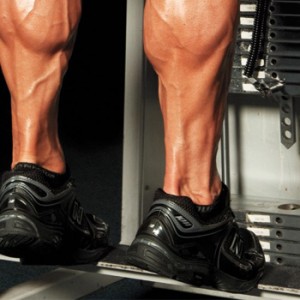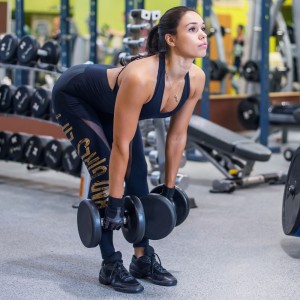Exercises


Standing Calf Raise Machine: How To Use, Benefits and Muscles Worked
Useful articles
The Standing Calf Raise Machine is the most effective exercise for the development of calf muscles. Its main advantage is that we can stretch the calves of the legs as much as possible at the lower point of the amplitude and statically shorten at the upper point. This is much more complicated than it seems at first glance. Many beginners do this exercise incorrectly, as they pick up a huge working weight and work at a minimum amplitude, without focusing on isolated the calf muscle for training. So, you will get a maximum of 10% benefit from this exercise if not done correctly. If you want to get the maximum result, you need to work in a different way. It will be hard and painful, but it will be worth it. Please read our article on how to do this correctly.
The Essence and Benefits of the Standing Calf Raise Machine
This exercise is your №1 weapon in the fight for a voluminous lower leg. Calf raises can be done in many variations: with dumbbells, with a barbell on the shoulders, in a Smith Machine, but best of all, in a special machine. All calf exercises are derived from the classic standing toe lift. By training your calves in the leg press machine, you are exactly repeating the biomechanics of lifting your calves while standing in the machine. The only difference is that there is no axial load on the spine.
Benefits
It’s enough to perform a standing toe lifts once a week, for example, at the end of a leg workout. This will be quite enough for their hypertrophy (muscle growth).
Do not forget that the calf muscles act as a stabilizer during basic exercises, such as the deadlift and frontal squats with a barbell. The stronger the stabilizer muscles are, the more weight you can lift. Therefore, the calves should be trained not only for those who want to have a beautiful muscular lower leg, but also for those athletes who set a goal to increase their working weights in basic movements. All experienced powerlifters and crossfit athletes find time in their training schedule to train their calves.
Contraindications
During the Standing Calf Raise Machine exercise, a strong load is created on the hamstring. For those who have already had problems with it, for example, from frontal squats, it is not recommended.
Also, in this exercise there is an axial load on the spine. How big it is, depends on the working weight. In this exercise, it is not recommended to use a large working weight, as it will be more difficult for you to focus on the work of the calves. But if the problems with the spine is really serious (hernias and protrusions in the cervical region, severe kyphosis or osteochondrosis), then it is better to train the calves in the leg press simulator. The biomechanics of movement are almost the same, but you will save your back from the unwanted load.

What Muscles do the Standing Calf Raises Work?
90% of the dynamic load falls on the calf muscles. The remaining load is distributed between the extensors of the spine, trapezius muscles, quadriceps and the buttocks.
For the full development of the lower leg muscles, you also need to train the soleus muscle, located under the calf. To do this, it is best to lift from your toes while sitting in the simulator. When the flounder muscle is well developed, it visually “pushes” the calf muscle out, and it takes on a more peak shape. This is the same story with the posterior and middle bundles of the deltoid muscles.
How to Use the Standing Calf Raise Machine?
Now there is a Standing Calf Raise Machine in almost every gym. Its main advantage is that it is convenient enough to stretch the muscles at the lower point of the amplitude, since there is still enough distance between the floor and the platform for the feet.
- The starting position for the exercise: we stand on the platform only with the toes of the foot, we lower the heels down and try to make them “fall” as much as possible. This is so that you feel a stretch in your calf muscles, so that everything is correct with the technique. This is our starting point and we need to bring each repetition to this point.
- At the lower point, we pause for a few seconds to further stretch the calf muscles. The exercise is performed in the maximum possible amplitude.
- Then we go up onto the tiptoes again, trying to get as high as possible.
- At the top, we make a peak reduction.
How long you need to hold depends on how much you are able to “squeeze” the calf muscles as much as possible to overcome the pain.
It’s very good if you can hold the peak contraction for 3-4 seconds. After 6-8 repetitions in this mode, you will feel a strong pumping sensation in the calf muscles. After another 5 minutes, you will feel severe pain. The task is to continue to work until a complete wear and tear feeling of fatigue is felt. When you can no longer do the maximum stretch and peak contraction, do a few more incomplete repetitions to finally load the muscles and finish of the exercise.

Frequently Asked Questions
How To Do Standing Calf Raises Without testosterone cypionate for sale a Machine?
If your gym does not have a Standing Calf Raise Machine, then you can do the exercise with a barbell or dumbbells. Its recommended not to overdo it with the working weight, as its important to feel the work of the muscles, and not just lift the pounds. Isolation of the muscles are key for this workout to become most effective.
How Much Does A Standing Calf Raise Machine Cost?
The average price for a Standing Calf Raise Machine is about $700.
How Much Weight does the Standing Calf Raise Machine hold?
The average weight of the Standing Calf Raise Machine is around 200kg.
Thank! Your message has been sent successfully.










Questions and answers 0